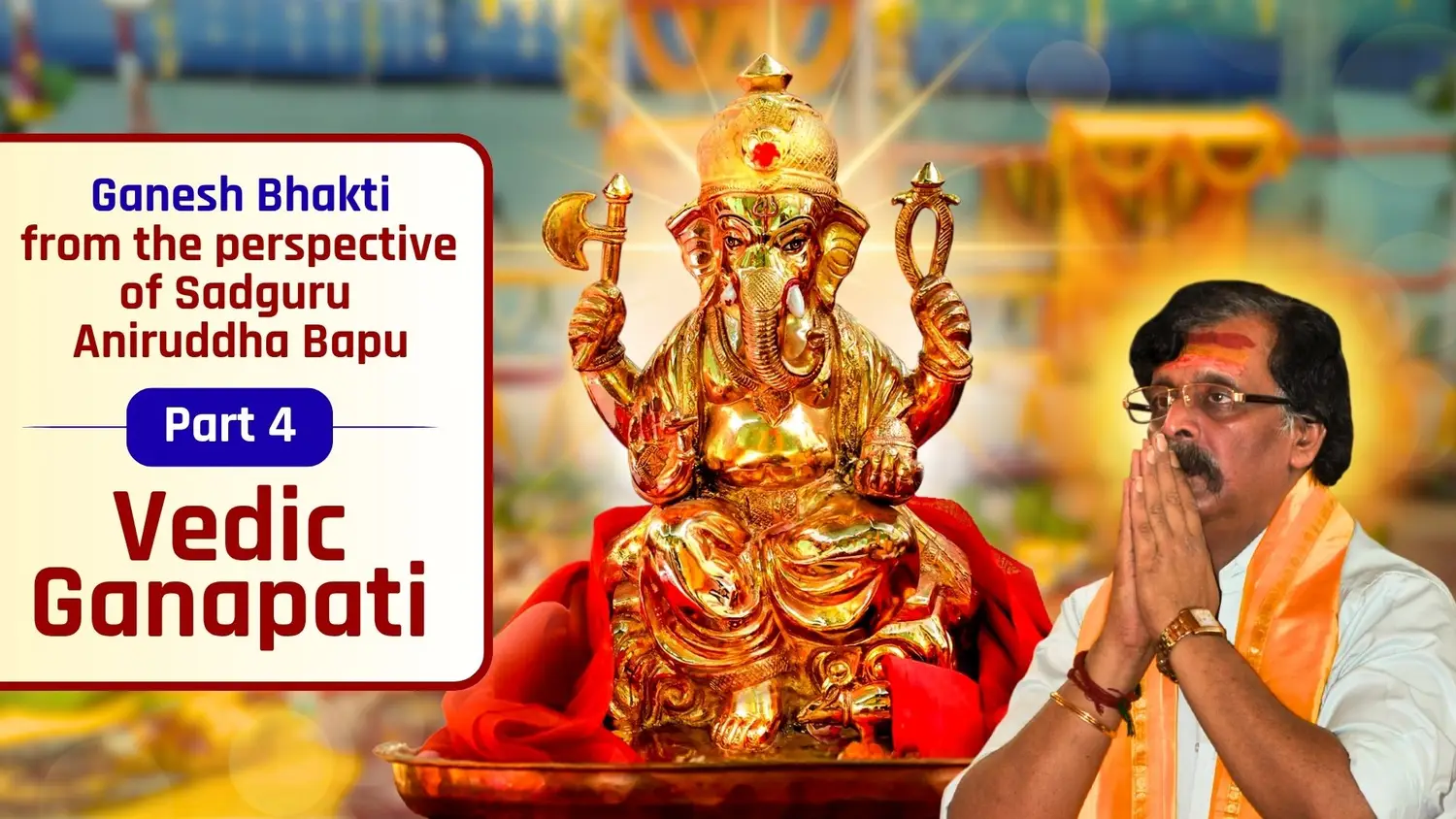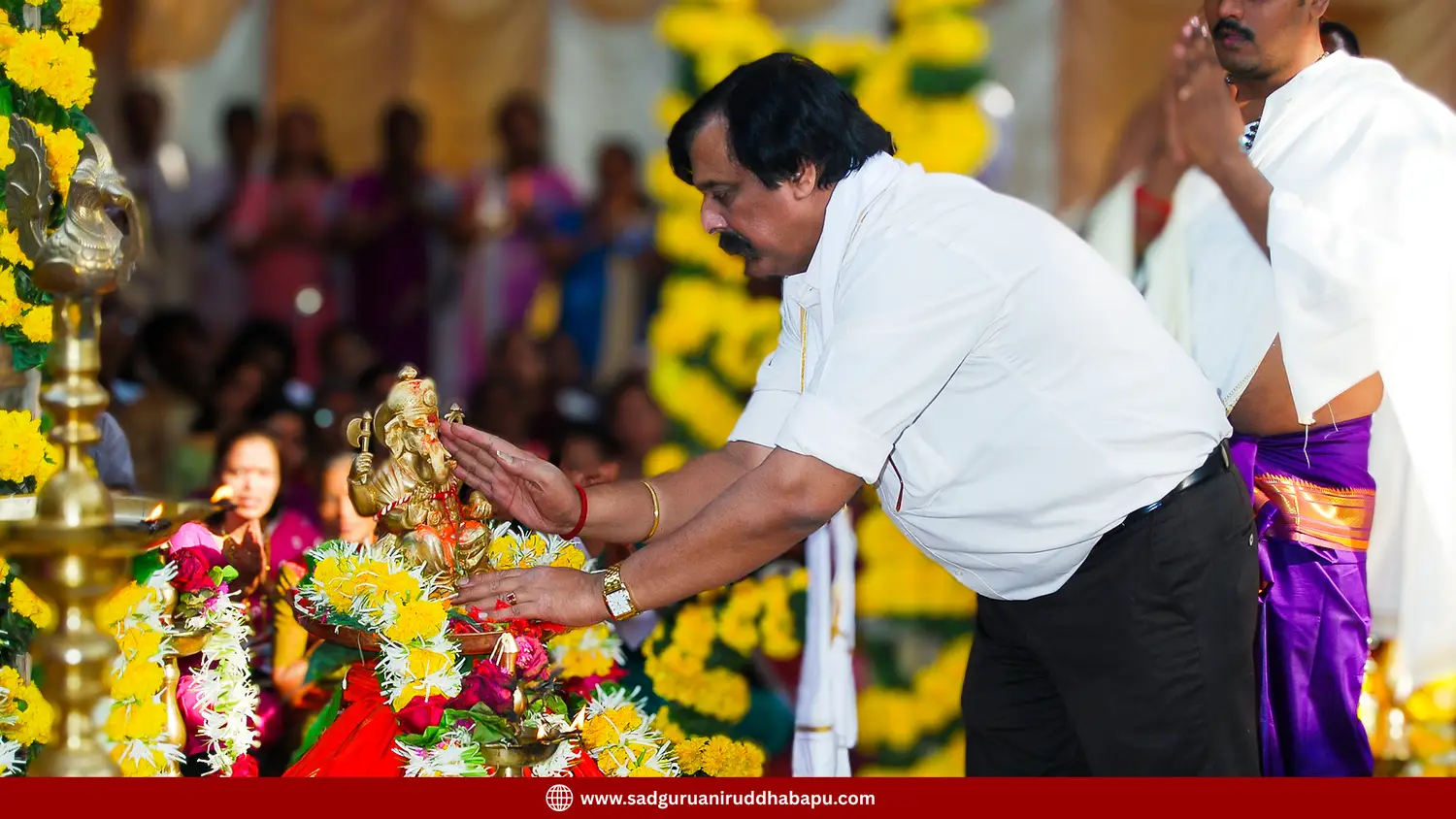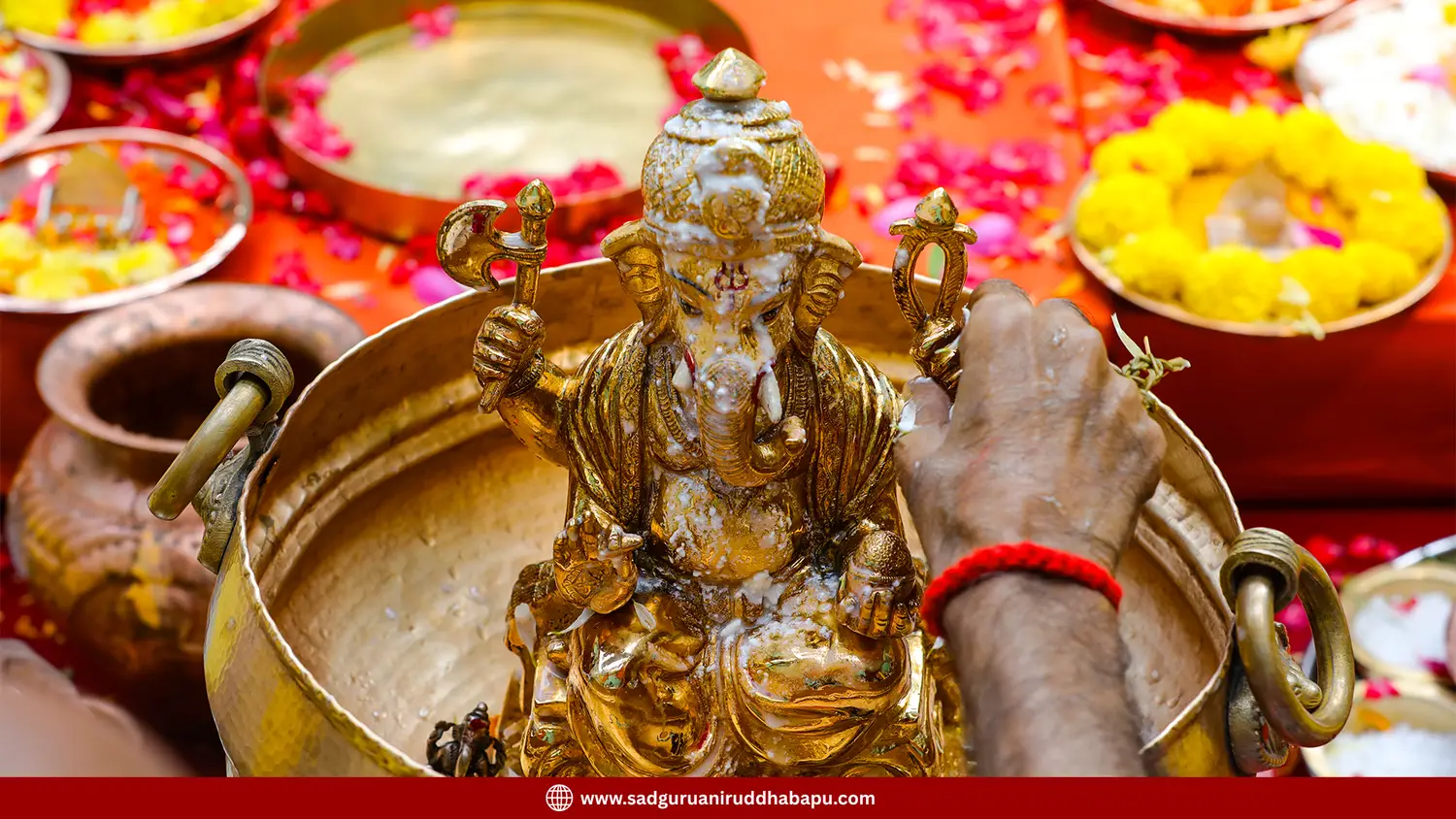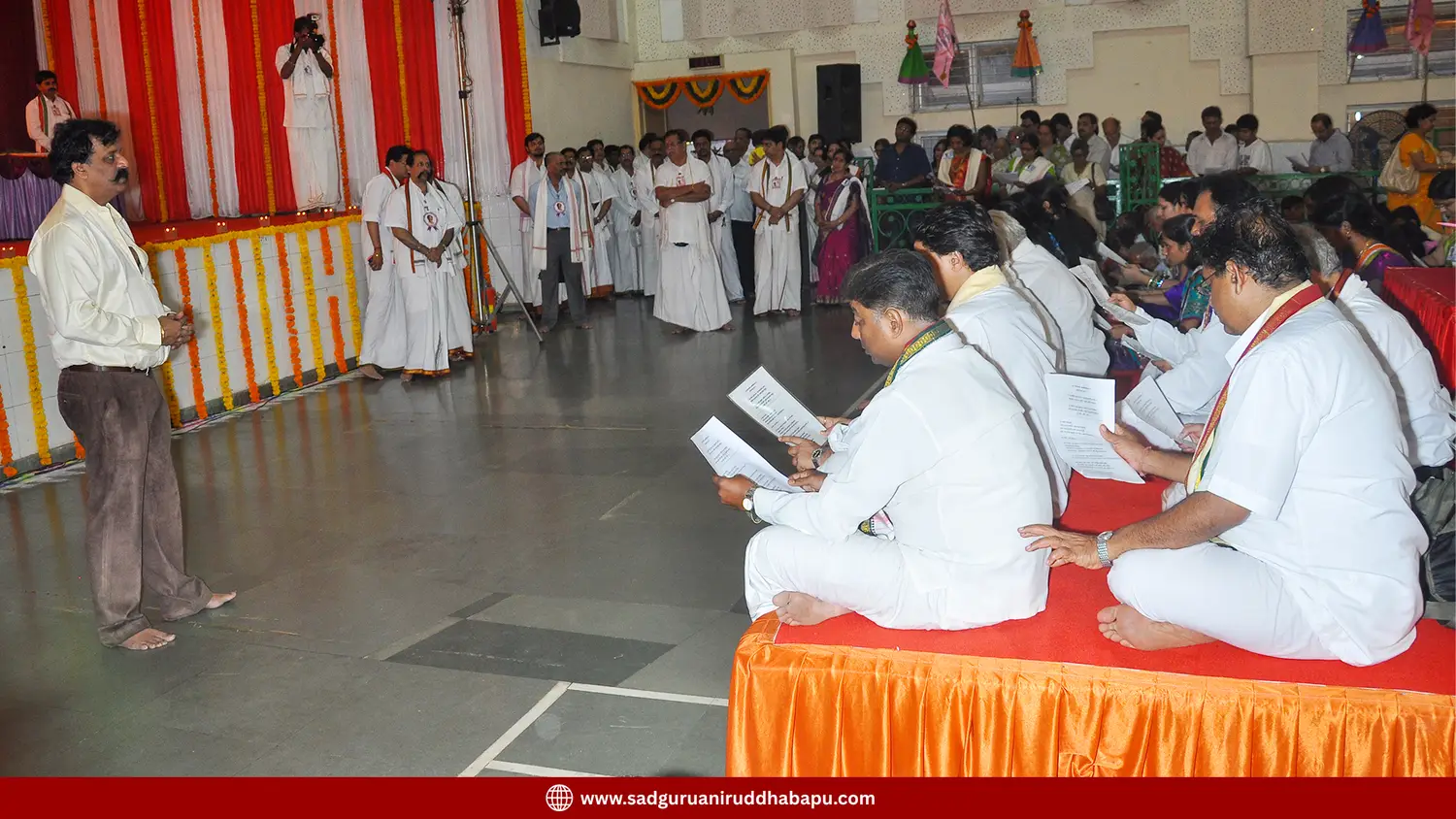Vedic Ganapati

मराठी हिंदी ગુજરાતી ಕನ್ನಡ বাংলা తెలుగు
Reference: Sadguru Shree Aniruddha Bapu’s editorial published in Dainik Pratyaksha dated 15-12-2006
‘The Vedic existence of Shri Ganapati is established through two powerful references: the Brahmanaspati Sukta from the Rigveda, and an Upanishad known as the Ganapati Atharvashirsha from the Atharvaveda.
The original Rigvedic mantra is as follows:
ॐ गणानां त्वां गणपतिं हवामहे कविं कवीनामुपमश्रवस्तमम् ।
ज्येष्ठराजं ब्रह्मणां ब्रह्मणस्पत आ नः शृण्वन्नूतिभिः सीद सादनम् ॥
Rigveda 2/23/1
O God of all groups (Ganas), Ganapati, the most intelligent among the intelligent, the most renowned among the renowned, and the sovereign among sovereigns. We invite You with utmost reverence; come with all Your power and grace, and be seated upon this seat (the Mooladhara Chakra). (Let only You hold authority over this sacred seat.)
Ganapati is another name for the Vedic deity Brahmanaspati, in other words, Ganapati is also known as Brahmanaspati.

During the Vedic era, every auspicious act began with the invocation of Brahmanaspati, and even today, using the same mantra, every sacred beginning is initiated by invoking Ganapati. The Brahmanaspati mentioned in the Rigveda is the giver of knowledge and the one with supreme wisdom, just as Shree Ganapati too is revered as the deity who bestows knowledge and intellect. The golden axe held by Brahmanaspati is still seen in the hands of Shree Ganapati today.
As ‘Harmony’ was the predominant principle in the ancient history of Bharat (India), various deities gradually merged into one at the spiritual level. Moreover, due to the Vedic doctrine that everything is “Brahma”, and the notion, ‘Ekam Sat Vipra Bahudha Vadanti’ (एकं सत् विप्रा बहुधा वदन्ति - The original reality (Parameshwar) is one; the wise know Him and call upon Him by various names), Indian culture never faced a problem in establishing the oneness of the tutelary deities (upasya devatas) worshipped across different sects even at a worldly level, despite the existence of many idols and forms.

In the collective psyche of Indian culture, the awareness of oneness i.e. Keshavatva behind the many forms of the Divine is so strongly embedded and deep-rooted that for the common people, whether educated or uneducated, debates about whether Shree Ganapati is a deity of the Aryans, a Vedic deity, a tribal deity, or a deity not mentioned in the Vedas but born of the Puranas, hold no real significance. These debates are relevant only to certain historical researchers or so-called atheistic intellectuals. True and sincere historians use their research on any deity solely as guiding pillars for understanding the history of culture whereas those with a malicious mindset use such research to create rifts within society. However, regardless of the method or the person conducting research on a deity, or expressing opinions based on personal beliefs, the existence of that deity on the spiritual plane can never be harmed or threatened.

Even if Ganapati is declared to be the deity of any particular group or community, His original form as the 'Vital Energy of the Universe' (Ghanapraan) neither changes nor will it ever cease to be. This is because Ganapati is not a deity established or made known through the research of scholars or historians. Rather, Ganapati manifested in His original form through the contemplation of sages who harmonized devotion and wisdom and it is with love that He was established in the hearts of devotees and gained widespread reverence because of mutual love between the worshipped and the worshipper. That is why the notion that the Brahmanaspati mentioned in the Rigveda was someone entirely different and merely referred to as Ganapati finds no place in a devotee's heart.
Ganapati, the son of Shiva and Parvati, is therefore rightfully the first to be revered and venerated in all auspicious acts performed by worshippers as well as across all spiritual sects. Shree Ganapati builds a beautiful bridge among all Shaivites, the worshippers of Devi, Vaishnavas, or those who worship the Sun.

The Shree Ganapati Atharvashirsha from the Atharvaveda clearly describes, in explicit terms, the popular and universally accepted form, weapons, and distinctive qualities of Shree Ganapati. In the Atharvashirsha as well, Shree Ganapati is clearly proclaimed as: “You are Rudra, Vishnu, Agni, Indra, Chandra, Surya, Varuna — You are everything.” Then what purpose would it serve to compare historical references of all these forms with the historical references of Ganapati? Such research amounts to nothing more than the meaningless and hollow chatter of those who have nothing worthwhile to do with their time, and it contributes not even a bit to the preservation of culture.
The revered Saint Dnyaneshwar Maharaj, whose authority on the path of knowledge is undisputed, wrote about Shree Ganapati at the very beginning of the Dnyaneshwari:
"ॐ नमो जी आद्या। वेद प्रतिपाद्या।
जय जय स्वसंवेद्या। आत्मरूपा॥
देवा तूचि गणेशु। सकलार्थमतिप्रकाशु।
म्हणे निवृत्तिदासु। अवधारिजो जी॥"
If one were to claim that Ganapati and Brahmanaspati are not one and the same, and that Ganapati finds no mention in the Vedas, then this very statement by Shri Dnyaneshwar Maharaj stands in strong contradiction to such a claim.
No matter how extensively one studies or research history using various sources, it remains true that in the vast and powerful flow of time, countless references and materials, thousands of times more than what is currently available have been lost. Therefore, when conducting research in the field of cultural history, no one can present their own opinion as the sole and absolute truth. A key characteristic of a living culture is its fluidity, that is, its continuous journey shaped by literally millions of factors and changes that have taken place over time. What ultimately and unshakably remains through all these changes is only the Absolute Truth and this Truth is not merely factual reality it is the reality which gives rise to purity and sanctity. It is from such sacred reality that true joy emerges. That is why the heart of a devotee is connected to this ‘Truth’, not merely to scraps of paper or pieces of evidence.
Whether the Brahmanaspati Sukta o.r the Atharvashirsha proves the Vedic identity of Ganesha is of no concern to me because every form that has been deeply rooted and enshrined in the heart of the devotee over thousands of years is, to me, none other than the form of that very Omkār, that Pranava, that very Keshava — I have never doubted this nor do I now, nor will I ever doubt for Keshava means ‘beyond the Shava (शव)’, means the original source of Chaitanya (consciousness) that lies beyond form and figure. Even if the entire world were to deny His existence, He simply cannot cease to be.
At the end of the editorial, Sadguru Shree Aniruddha Bapu writes —
"My friends, this is why, instead of engaging in endless, fruitless debates, offer your worship to the Paramatma with complete faith and devotion for the Almighty is indeed capable of bringing your efforts to fulfillment."
